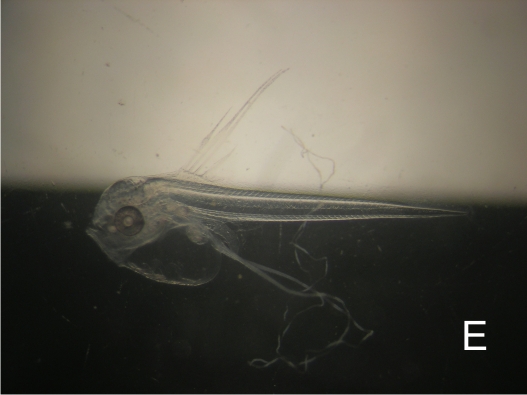Lampriformes: Lampridae: H I A2A
Lampris cf guttatus (Brunnich, 1788)
Spotted opah


Egg diameter in µm |
Number of oil globules |
Diameter of oil globule in µm |
Yolk texture |
Perivitelline space |
Position of oil globule at hatch |
Gut length at eye- pigment stage |
Myomeres |
2350 |
0 |
n/a |
clear |
narrow |
n/a |
36% of NL |
ca 45 |
Egg: This egg has only been seen on two DNA confirmed occasions, but was easily recognised by its red chorion. It was only confused with CDIA1 when that species lacked a furry chorion, and HIA2. Incubation is at least 10 days (23°C).
Larva description: The newly hatched larva has lightly pigmented eyes, with long dorsal and pelvic fin elements (D). The larva resembles other lampriformes, but instead of a single dorsal fin thread with leaflike expansions as seen in Regalecus (CDIA1) and Zu cristatus larvae ( HIA2), has 4 elongate dorsal spines, and long threadlike extensions to the pelvic fins. D: 2 days PH, 14 days post collection; E: NH 13 days post collection.
Four larvae, hatched from eggs, have been barcoded, submitted under my egg codes CDIA1, CDIA1A and HIA2 (2x). They provided a match with adult fish identified as Lampris guttatus, from Australia (BOLD). The barcode of an adult collected off Durban and identified as L. guttatus (TZMSA442-04|ADC117.1-1 in BOLD), does not match these four larvae, although it does match sequences of other adults from Australia (BOLD). Evidently, there are two cryptic species in southern hemisphere waters, and both occur off our coast. In fact there are three species in this complex, the third apparently confined to the northern hemisphere (Meagan Sundberg, NOAA, Hawaii, pers.comm.). A paper is currently in preparation to describe the northern hemisphere species, while the southern hemisphere complex requires review.
All the eggs were collected in warm water months, one in January 2009, one in December 2009, and 2 in April 2012.